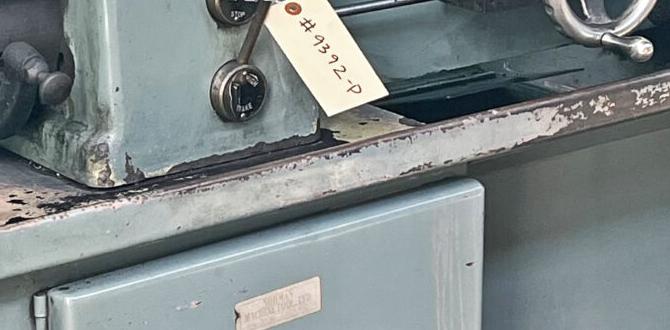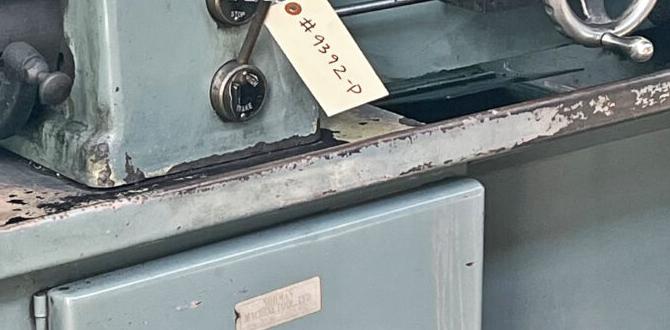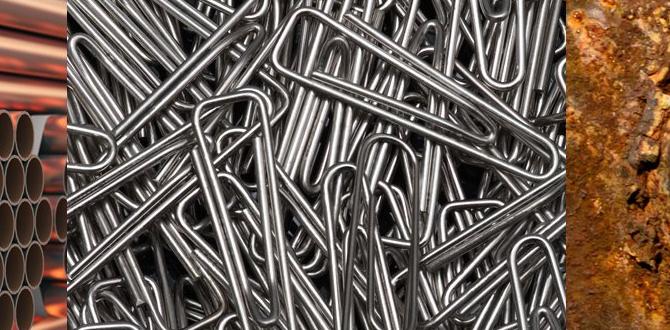Have you ever watched a magician turn a block of wood into something amazing? That’s the magic of using tools like the wood lathe parting tool. Imagine you’re holding a wand, ready to shape and create. But instead of a wand, you have a sharp parting tool in your hands.
This tool is special because it helps carve out cool designs. But what if you could make toys or even a little bowl with it? The parting tool might look simple, but it’s very mighty. It can cut and shape wood like a hot knife through butter.
Here’s a fun fact: did you know some people use a wood lathe parting tool to make custom chess pieces? Picture someone turning plain wood into something beautiful on a lazy afternoon. How do you think they do it so smoothly? It’s the parting tool working its magic!
Stick around to learn more about this cool tool. You’ll see how it turns wood into a masterpiece, one slice at a time.
Understanding Wood Lathe Parting Tool Use And Techniques Introduction Wood Lathe Parting Tools Are Essential For Woodturning Enthusiasts And Professionals Alike. Understanding Their Use Greatly Enhances The Quality And Efficiency Of Your Projects. In This Article, We Will Explore The Functional Aspects Of The Parting Tool, Techniques For Effective Usage, And Tips For Maintaining This Vital Instrument. What Is A Wood Lathe Parting Tool? A Wood Lathe Parting Tool Is A Specialized Cutting Tool Designed To Create A Narrow Cut Or Groove In Wood. It Is Generally Used For Separating A Turned Project From The Wood Lathe Or For Shaping Intricate Designs. The Tool Typically Has A Narrow Blade That Allows For Precision And Control While Cutting. Primary Uses Of A Parting Tool 1. **Separating Workpieces**: One Of The Main Uses Of A Parting Tool Is To Cut Through The Wood To Separate The Finished Piece From The Remaining Stock On The Lathe. This Requires Careful Handling To Ensure A Clean And Smooth Separation. 2. **Creating Decorative Grooves**: Parting Tools Can Also Be Employed To Create Decorative Lines And Grooves That Enhance The Visual Appeal Of The Final Project. Skilled Woodturners Often Use Them To Add Detail To Intricate Designs. 3. **Establishing Depths**: Parting Tools Help In Establishing The Depth Of Cuts When Hollowing Out Sections Of A Workpiece, Allowing For Greater Control Over The Final Dimensions And Appearance Of The Project. Techniques For Effective Use – **Proper Angle**: Maintain A Correct Angle Between The Tool And The Wood To Avoid Excessive Resistance, Which Can Lead To Breakage Or An Uneven Cut. – **Steady Pressure**: Apply Consistent Pressure While Cutting—Too Much Force Can Overpower The Tool And Lead To Mistakes, While Too Little Can Cause Incomplete Cuts. – **Multiple Passes**: For Deeper Cuts, Make Multiple Passes Rather Than Trying To Complete The Cut In One Go. This Ensures A More Controlled And Precise Outcome. Maintenance Tips – **Regular Sharpening**: Keep The Blade Sharp To Ensure Clean Cuts And Prolonged Tool Life. Dull Blades Can Lead To Rough Finishes And More Significant Wear On The Tool Itself. – **Clean After Use**: Clean The Parting Tool After Each Use To Remove Any Resin Buildup Or Debris That Can Hinder Its Efficiency. – **Proper Storage**: Store The Tool In A Protective Case Or Holder To Avoid Damaging The Blade And Ensure Safety. Conclusion Mastering The Use Of A Wood Lathe Parting Tool Is Crucial For Anyone Serious About Woodturning. By Understanding Its Purposes, Employing Effective Techniques, And Practicing Proper Maintenance, You Can Significantly Improve Your Craft And Produce Stunning Results In Your Woodworking Projects.

Wood Lathe Parting Tool Use
The wood lathe parting tool helps in shaping and cutting wood. It creates clean grooves for separating pieces. Have you ever wondered how a woodturner finishes their unique projects? This tool makes it possible! It glides smoothly through wood, providing precision. Beginners often find it challenging, but practice makes perfect. Did you know that using the right angle can enhance the tool’s effectiveness? Mastering the parting tool opens up endless creative possibilities in woodturning!Understanding the Wood Lathe Parting Tool
Definition and purpose. Key features and types.Imagine slicing through wood with the elegance of a samurai—enter the wood lathe parting tool! Its main job? Dividing parts from your spinning masterpiece. Like a trusty sidekick, it helps carve precise cuts straight down to the lathe’s bed. Parting tools come in various types like diamond, flat, and round. Each has its own flair and style for different tasks. Who knew slicing wood could have so much pizzazz?
| Tool Type | Shape | Uses |
|---|---|---|
| Diamond | Triangular | Detailed Cuts |
| Flat | Rectangular | General Work |
| Round | Cylindrical | Smooth Finishing |
Asking yourself, “Why use a parting tool?” Well, think of it as the ninja of your lathe arsenal—it can make cuts in the blink of an eye! According to experts, choosing the right type ensures cleaner cuts and less wear on your tools. So, next time you’re in the workshop, let this tool be the star of your wood-spinning show!
Applications of the Parting Tool in Woodturning
Creating grooves and decorative lines. Parting off finished pieces.Imagine you want to add cool details to a wooden stick. The parting tool in woodturning helps you do that! It can create neat grooves and decorative lines. Groove or line, it makes the wood look fancy and nice. Next, it helps in parting off finished pieces. After shaping, use the tool to separate the piece you worked on. It’s fast and clean. So, with this tool, both designing and finishing become easy!
What is a parting tool used for?
The parting tool is used in woodturning to make grooves or lines. It helps create designs. Also, it can cut and separate finished parts. This makes it very handy for both creative designs and final touches.
- Create neat grooves.
- Part off completed pieces.
If you want to add lovely details or clean separations, consider using a parting tool.
How does it help in woodturning?
In woodturning, the parting tool makes creating patterns easy. It’s like having a magic wand to make lines and cut pieces from your work. This tool turns simple wood into something extraordinary. Try it and see!
Choosing the Right Parting Tool for Your Project
Factors to consider: size, material, and handle. Comparison of popular brands and models.Finding the best parting tool for your project can be like picking the right superhero gadget. You need to think about its size: too big, and it’s like using a sword to peel an apple! Then, consider the material, because no one wants a butter knife when slicing timber. Also, check the handle—a comfy grip can mean the difference between a masterpiece and a mess. As for brands, some popular ones include ABC Tools and WoodMarvels. Remember, like trading cards, all models are not equal. Collect wisely!
Here’s a simple comparison table to help you:
| Feature | ABC Tools | WoodMarvels |
|---|---|---|
| Size Options | Small, Medium | Medium, Large |
| Material Quality | High | Medium |
| Handle Comfort | Ergonomic | Standard |
Remember, the right tool should feel like an extension of your own hand. As the saying goes, “The best tool is one you barely notice.” With these expert tips, you’re ready to cut the perfect groove, not your finger!
Proper Techniques for Using a Parting Tool
Setting up your lathe. Basic cutting techniques and tool angles.Go ahead and imagine you’re a wood wizard with a magic wand. That wand? It’s your lathe, so snugly fastened it’s like it’s in a bear hug. Picture this: one hand steadying the wood, while the other wields the parting tool like a superhero uses a sword. Now for the trick—never go head-on like charging a bull! Instead, tilt that tool at a graceful angle. It’s like you’re slicing through butter, but sneakier. With a smile, remember: if you’re sweating, you’re doing it wrong! Even wood loves the gentle touch. Give it a try, and soon you’ll be churning out masterpieces!
Safety Tips and Best Practices
Protective gear and setup precautions. Tips to avoid common mistakes.Wearing the right gear is important when using a wood lathe. Always wear safety glasses to protect your eyes. Use ear protection if it is loud. Gloves can help, but be careful not to catch them in the tool. Set up your workspace well. Make sure your tools and the lathe are, tight and without any wobble.
How can I avoid common mistakes with a parting tool?
Holding the tool wrong is a common mistake. Keep your hands steady and control the tool. Don’t rush while cutting. Move the tool slowly. Keep the sharp part sharp. It works best that way.
- Stand firm and balanced.
- Keep kids away from the work area.
- Measure twice before cutting once.
Did you know that many accidents happen when people forget simple steps? Safety is not hard if you think carefully before each step.
Maintaining and Sharpening Your Parting Tool
Tool maintenance essentials. Stepbystep guide to sharpening.Maintaining and Sharpening Your Parting Tool
Keeping your parting tool in top shape is easy. The first step is to clean it after each use. Wipe off any dust or wood shavings. This will help the tool stay sharp longer. Also, check if it feels dull. If it does, it’s time to sharpen it.
- Hold the tool against the grinding wheel.
- Keep the blade at the right angle.
- Move it back and forth gently.
- Finish by honing the edge with a sharpening stone.
How do you sharpen a wood lathe parting tool?
To sharpen a wood lathe parting tool, you need to keep the tool at the correct angle against the grinder. Move it gently and evenly. This ensures you get a sharp edge.
Exploring Advanced Techniques with the Parting Tool
Integrating with other woodturning tools. Creative designs and patterns.When mixing the parting tool with other woodturning tools, you’ll find a world of possibilities! Imagine creating patterns so unique that even your cat might feel jealous. You can carve out lines and grooves that look like art pieces. Although it sounds fancy, mastering these techniques even makes the wood whisper. Learn to use crosshatching with striking precision, and soon you’ll craft designs worthy of a museum.
Here’s a little table magic for your crafting journey:
| Tool | Use Case | Fun Fact |
|---|---|---|
| Parting Tool | Creating Grooves | First tool to have a “defining line”! |
| Bowl Gouge | Smooth Curves | It turns bowls like a pro chef! |
| Skew Chisel | Finishing Touches | Often nicknamed “the sassy chisel”! |
Using them together can help you carve infinite designs. Experts say, “Practice aligns creativity and precision.” And remember, each tool adds its own flair to your work.
Addressing Common Challenges and FAQs
Troubleshooting uneven cuts. Answers to frequently asked questions about parting tool use.Trying to make straight cuts with a parting tool can be tricky. If cuts are uneven, your wood might not be spinning right. This can make one side deeper. Check the spin and adjust.
Why does the tool bounce?
The tool might bounce if it’s not sharp enough. A dull tool can slip. Sharpen it for a better grip.How to avoid tool chatter?
- Tighten your grip and tool rest.
- Keep the lathe speed steady.
Fix a cracked parting tool by replacing it right away! Safety comes first.
Remember, practice makes perfect. As you use the parting tool, you’ll get better each time. Experts say, “A steady hand makes smooth cuts.” Your skills will grow with patience.
Conclusion
In summary, a wood lathe parting tool is essential for making clean cuts and shaping wood. You can easily create grooves and separate pieces with practice. Remember to hold the tool firmly and work slowly. We encourage you to try using one in your next project. Keep reading and learning to become a better woodworker!FAQs
How Do You Properly Set Up A Parting Tool On A Wood Lathe For Accurate Cuts?Here’s how you set up a parting tool on a wood lathe: Wear safety goggles to protect your eyes. Make sure your parting tool is sharp and clean. Put the tool rest close to the wood piece, about an inch away. Hold the tool steady and keep it at a 90-degree angle to the wood. Start the lathe and gently move the tool into the wood. Always take your time and be careful.
What Are The Common Mistakes To Avoid When Using A Parting Tool On A Wood Lathe?When using a parting tool on a wood lathe, don’t push too hard. It can break or hurt you. Keep the tool sharp; dull tools don’t cut well. Always wear safety goggles to protect your eyes. Make sure the wood is secure and won’t move around. Don’t rush; take your time and be careful.
Can You Explain The Differences Between Traditional And Carbide-Tipped Parting Tools?Sure! Traditional parting tools have blades made from strong steel. We use them to cut through materials. They can wear out quickly if used a lot. Carbide-tipped parting tools have a special tip that stays sharp longer. This makes them good for tougher jobs and they don’t need replacing as often.
What Safety Precautions Should Be Taken When Using A Parting Tool On A Wood Lathe?When you use a parting tool on a wood lathe, keep your fingers far from the spinning wood. Wear safety goggles to protect your eyes from flying chips. Make sure you hold the tool tightly to stay in control. Stand to the side, not directly in front, in case something flies off. Also, make sure your work area is clean and tidy.
How Can You Maintain And Sharpen A Parting Tool To Ensure Optimal Performance?To keep a parting tool working well, you must clean it after each use. Make sure there is no dirt on it. You also need to sharpen it when it gets dull. Use a special stone to gently rub the edges. Ask an adult to help you if you’re unsure.








